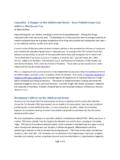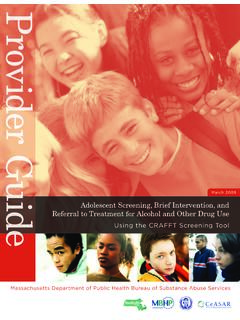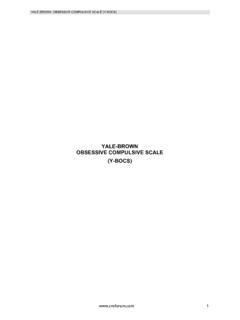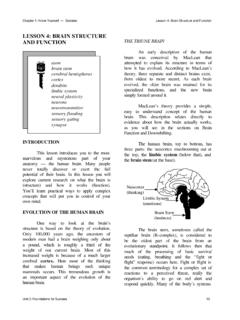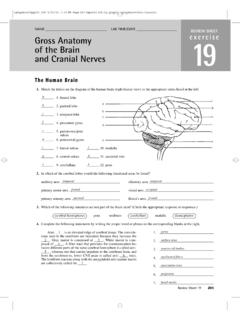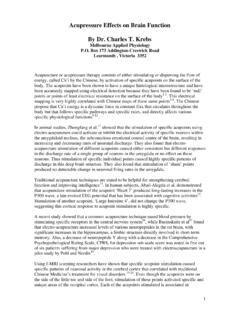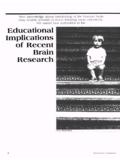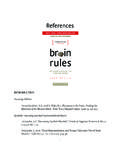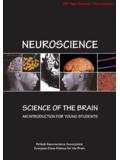Transcription of Cannabis: A Danger to the Adolescent Brain How ...
1 Cannabis: A Danger to the Adolescent Brain How Pediatricians Can Address Marijuana Use By Elaine Gottlieb Experimenting with sex, alcohol, and drugs is common during adolescence. Among illicit drugs, marijuana is the most commonly used. The liberalization of marijuana laws and increasing availability of medical marijuana have led to greater acceptance of the drug among adults and adolescents who view it as non-addictive and less harmful than other drugs. A recent survey of Massachusetts students showed a decline in the perceived harmfulness of marijuana and a reversal of a decade-long decrease in marijuana use.
2 According to the CDC national Youth Risk Behavior Survey (YRBS), 43 percent of Massachusetts teens have used marijuana one or more times. Teens think that if marijuana is used as a medicine, it must be safe, says John Kulig, MD, MPH, Director, Adolescent Medicine, Tufts Medical Center, and Professor of Pediatrics, Public Health and Community Medicine, Tufts University School of Medicine. Teens who say they would never smoke tobacco admit they do smoke marijuana.. This is a dangerous trend, as new advances in developmental neuroscience show that Adolescent brains are differentially vulnerable to the neurotoxic effects of cannabis.
3 As a result, an American Academy of Pediatrics AAP policy statement recommended against the legalization of marijuana because it might lead to increased use among adolescents. The earlier an Adolescent starts smoking, the earlier the potential changes to Brain structure and function, says John Knight, MD, Senior Associate in Medicine and Associate in Psychiatry, Children's Hospital Boston and Associate Professor of Pediatrics, Harvard Medical School. Marijuana's Effects on the Adolescent Brain Neuroscience has shown that the human Brain continues to develop into the mid to late twenties.
4 During the first decade of life, Brain growth occurs mainly in the gray matter (neurons and dendrites). and during the second and third decades, it occurs primarily in the white matter (connectivity). Exposure to neurotoxins during the Brain 's developmental period can permanently alter the Brain 's structure and function.. The main psychoactive substance in cannabis is delta-9-tetrahydrocannabinol (THC). When marijuana is smoked, THC moves quickly from the lungs to the bloodstream and the Brain , causing an immediate high. THC acts on the endocannabinoid system, which is present in the fetal Brain and plays a critical role in normal Brain development and function; it affects the growth, differentiation and final positioning of neurons as well as connectivity among neurons.
5 THC binds to two major cannabinoid receptors, CBR1 and CBR2. CB1 receptors are concentrated in the hippocampus (memory), amygdala (emotion and anxiety), nucleus accumbens (reward and motivated behavior), hypothalamus (appetite, Page 1 of 4. stress), basal ganglia (movement), and cerebellum (muscle coordination). CB2 receptors are located mainly in the immune system. Like other addictive substances, such as opioids, THC activates the reward system by stimulating the release of dopamine. Exogenous cannabinoids such as THC can disrupt the development of neural pathways, especially in adolescents who are chronic marijuana users.
6 When you interfere with connectivity, there are changes in higher order thinking and memory, says Dr. Knight. While there is conflicting information related to cannabis' long-term neurocognitive effects, there is no debate that adolescence is a very vulnerable time to put extraneous substances into the Brain . While some adolescents report being able to use marijuana without a major negative impact, they are not always aware of the deficits in learning and memory related to their use, says Mona Potter, MD, Child and Adolescent Psychiatrist at The Landing/Dual Diagnosis Adolescent Residential Treatment Unit at McLean Hospital.
7 Marijuana and Mental Health Disorders Early marijuana use is associated with the development later in life of serious mental health disorders: addiction, major depression, anxiety, and psychotic disorders such as schizophrenia. One systematic review estimated a 40 percent increase in the risk of psychosis among adolescents who had tried cannabis and a 50 to 200 percent increase among more frequent, heavy users. Daily use of cannabis in high school is associated with a six-fold increase in depression and anxiety later in life. Taking high doses of marijuana can cause short-term acute psychosis with symptoms such as hallucinations, delusions, and loss of the sense of personal identity.
8 Cannabis is a very impairing drug;. it's just as dangerous as alcohol and stays in the system much longer, says Dr. Knight. Cannabis use can lead to amotivational syndrome which impedes learning and schoolwork. These kids have muddled brains; they can't participate in group or individual therapy, can't think straight, or make life plans. Users think they are more creative when they smoke marijuana but they only feel more creative, says Dr. Knight. Contrary to popular belief, marijuana is addictive: there are more youths in treatment for marijuana dependence than any other drug.
9 Cannabis causes both the physiologic symptoms of drug withdrawal as well as psychological dependence. Some adolescents who are addicted to opiates report finding it harder to quit marijuana than opiates. They are surprised that it isn't as easy as they thought it would be, says Dr. Kulig who treats opioid-dependent youth. When adolescents use marijuana they are learning a certain way to cope with life. Instead of, for example, learning how to handle anxiety, they use marijuana. It blunts personal and developmental growth, says Dr.
10 Potter. Page 2 of 4. Risk Factors Adolescents who smoke marijuana may have parents who are permissive or who are smokers (30. percent of suburban parents use marijuana), have friends who use the drug, have poor academic performance, or be involved in other negative behaviors, such as drinking alcohol and smoking cigarettes. Habitual users may have a family history of drug or alcohol abuse or comorbidities such as depression and anxiety. If you're anxious and depressed, do you use marijuana to self-medicate or does the drug itself cause the symptoms?
